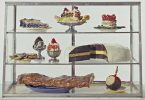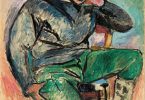
It is paradoxical, on a sultry summer morning in Southampton, New York, land of designer labels and ladies-who-lunch, to walk into the cool calm of the Parrish Art Museum, where the gallery ceilings resemble those of an old railway station, and to view Adam Bartos’ exhibit, Liminal Ground, Long Island Photographs (2009-2011). These are not photos of high society homes or pale sand beaches, but instead, “images of places in between that might well go unrecorded were they not framed with his virtuoso camera.”*






